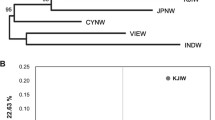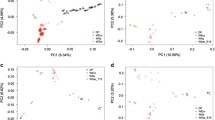Abstract
The analysis involved wild boars from the Lublin region, Warmia and Mazury, and Wielkopolska. The study material comprised muscle tissue samples collected from 100 wild boars. We analysed loci S0008, SW1129, SW986, SW1465, SW1492, SW1514, SW2532, SW461, SW841, SW2021, and SW2496 [1, 2]. The largest number of specific alleles, i.e. in six loci, was observed in wild boars from Warmia and Mazury; in turn, there were only two alleles in the group of wild boars from Lublin, and no alleles in individuals from Wielkopolska. The average value of the observed heterozygosity was Ho = 0.51, and the average value of expected heterozygosity was He = 0.63. PIC was another analysed indicator, with its lowest value determined for wild boars from the Wielkopolska region (0.53), and the highest value (0.62) was found for the animals from Warmia and Mazury. In the study population of wild boars, we also determined the FST index, which was 0.073, and Nm had a value greater than 3 (3.15); therefore, it can be concluded that the number of migrants per generation was 3. Both coefficients confirm the possibility of gene transfer and reproduction within and between the analysed populations of the wild boars. In our study, we observed a greater genetic distance between the wild boar populations from Wielkopolska and the Lublin and Warmia and Mazury regions in spite of the smaller geographical distance of these lands. This may be caused the less extensive network of ecological corridors as well as the occurrence of anthropogenic barriers e.g. large urban centres, an extensive network of roads, and the high volume of traffic in the direction of the capital.
Similar content being viewed by others
References
Ferreira, E., Souto, L., Soares, A.M.V.M., and Fonseca, C., Genetic structure of the wild boar (Sus scrofa L.) population in Portugal, Wildl. Biol. Pract., 2006, vol. 2, no. 1, pp. 17–25.
Vernesi, C., Crestanello, B., Pecchioli, E., et al., The genetic impact of demographic decline and reintroduction in wild boar (Sus scrofa): a microsatellite analysis, Mol. Ecol., 2003, vol. 12, pp. 585–595.
Choi, S.K., Lee, J.E., Kim, Y., et al., Genetic structure of wild boar (Sus scrofa) populations from East Asia based on microsatellite loci analyses, BMC Genet., 2014, vol. 15, p. 85.
Kamieniarz, R. and Panek, M., Wild Game in Poland at the Turn of the Century OHZ PZŁ, Czepiń, 2008.
Okarma, H. and Tomek, A., Hunting, Krakow: Education and Scientific H2O, 2008.
Szczepański, W., Janiszewski, P. and Kolasa, S., Biometric characteristic of the wild boar (Sus scrofa L.) from north-eastern Poland, Baltic For., 2003, vol. 9, no. 2, pp. 83–88.
Oliver, W.L.R., Brisbin, J., and Takahami, S., The Euroasian wild pig (Sus scrofa), Oliver, W.L.R., Ed., A Status Survey and Conservation Action Plan for Pig, Pecaries and Hippos, Gland: International Union for the Conservation of Nature, 1993, pp. 112—121.
Spitz, F., General model of spatial and social organization of the wild boar (Sus scrofa), Ongules/Ungulates, Spitz, F., Janeau, G., and Aulangier, S., Eds., Toulouse: SFEPM-IRGM, 1992, vol. 91, pp. 385–389.
Boitaini, L., Mattei, L., Nonis, D., and Corsi, F., Spatial and activity patterns of wild boar in Tuscany, J. Mammal., 1994, vol. 75, pp. 600–612.
Soideikat, G. and Pohlmeyer, K., Escape movements of family groups of wild boar Sus scrofa influenced by drive hunts in Lower Saxony, Germany. Wild. Biol., 2003, vol. 9, suppl. 1, pp. 43–49.
http://www.ncbi.nlm.nih.gov/.
Raymond, M. and Rousset, F., GENEPOP (3.4): population genetics software for exact tests and ecumenicism, J. Hered., 1995, vol. 86, pp. 248–249.
Excoffier, L., Laval, G., and Schneider, S., Arlequin ver. 3.0: an integrated software package for population genetics data analysis, Evol. Bioinf. Online, 2005, vol. 1, pp. 47–50.
Rodriganez, J., Barragan, C., Aloes, E., et al., Genetic diversity and allelic richness in Spanish wild and domestic pig population estimated from microsatellite markers, Span. J. Agric. Res., 2008, vol. 6, special issue, pp. 107–115.
Shenglin, Y., Genetic diversity of Tai indigenous pigs, wild boars and Chinese Qianbei black pigs based on microsatellite DNA and sequence polymorphism of mitochondria DNA cytochrome b gene, Doctor Thesis, 2007.
Scandura, M., Iacolina, L., Crestanello, B., et al., Ancient vs. recent processes as factors shaping the genetic variation of the European wild boar: are the effects of the last glaciation still detectable?, Mol. Ecol., 2008, vol. 17, pp. 1745–1762.
Vielickovic, N., Djan, M., Obreht, D., and Vapa, Lj., Population genetic structure of wild boars in the West Balkan region, Russ. J. Genet., 2012, vol. 48, no. 8, pp. 859–863. doi 10.1134/S1022795412080078
Günther, B. and Csaikl, H.F., Genetic variability and differentiation in wild boars (Sus scrofa ferus L.) comparison of isolated populations, J. Mamm., 1987, vol. 68, no. 1, pp. 119–125.
Kim, T.H., Kim, K.S., Choi, B.H., et al., Genetic structure of pig breeds from Korea and China using microsatellite loci analysis, Am. Soc. Anim. Sci., 2005, vol. 83, pp. 2255–2263.
Spencer, P.B.S., Hampton, J., Lapidge S.J., et al., An assessment of the genetic diversity and structure within and among populations of wild pig (Sus scrofa) from Australia and Papua New Guinea, J. Genet., 2006, vol. 85, no. 1.
Pilot, M., The Use of Molecular Methods in Studies of Ecological, Warsaw: Museum and Institute of Zoology PAN, 2005.
Ferreira, E., Souto, L., Soares, A.M.V.M., and Fonseca, C., Genetic structure of the wild boar population in Portugal: evidence of a recent bottleneck, Mamm. Biol., 2009, vol. 74, pp. 274–285.
Avise, J.C., Molecular Markers, Natural History, and Evolution, Warsaw: WUW, 2008.
Slatkin, M., Rare alleles as indicators of gene flow, Evolution, 1985, vol. 39, pp. 53–65.
Perzanowska, J., Makomaska-Juchiewicz, M., Cierlik, G., et al., Ecological Corridors in Malopolska, Institute of Environmental Sciences, 2005.
Fang, M. and Andersson, L., Mitochondrial diversity in European and Chinese pigs in consistent with population expansions that occurred prior to domestication, Proc. R. Soc. London, Ser. B, 2006, vol. 273, pp, 1803–1810.
Author information
Authors and Affiliations
Corresponding author
Additional information
The article is published in the original.
Rights and permissions
About this article
Cite this article
Tajchman, K., Drozd, L., Karpiński, M. et al. Population Genetic Structure of Wild Boars in Poland. Russ J Genet 54, 548–553 (2018). https://doi.org/10.1134/S1022795418050101
Received:
Published:
Issue Date:
DOI: https://doi.org/10.1134/S1022795418050101




